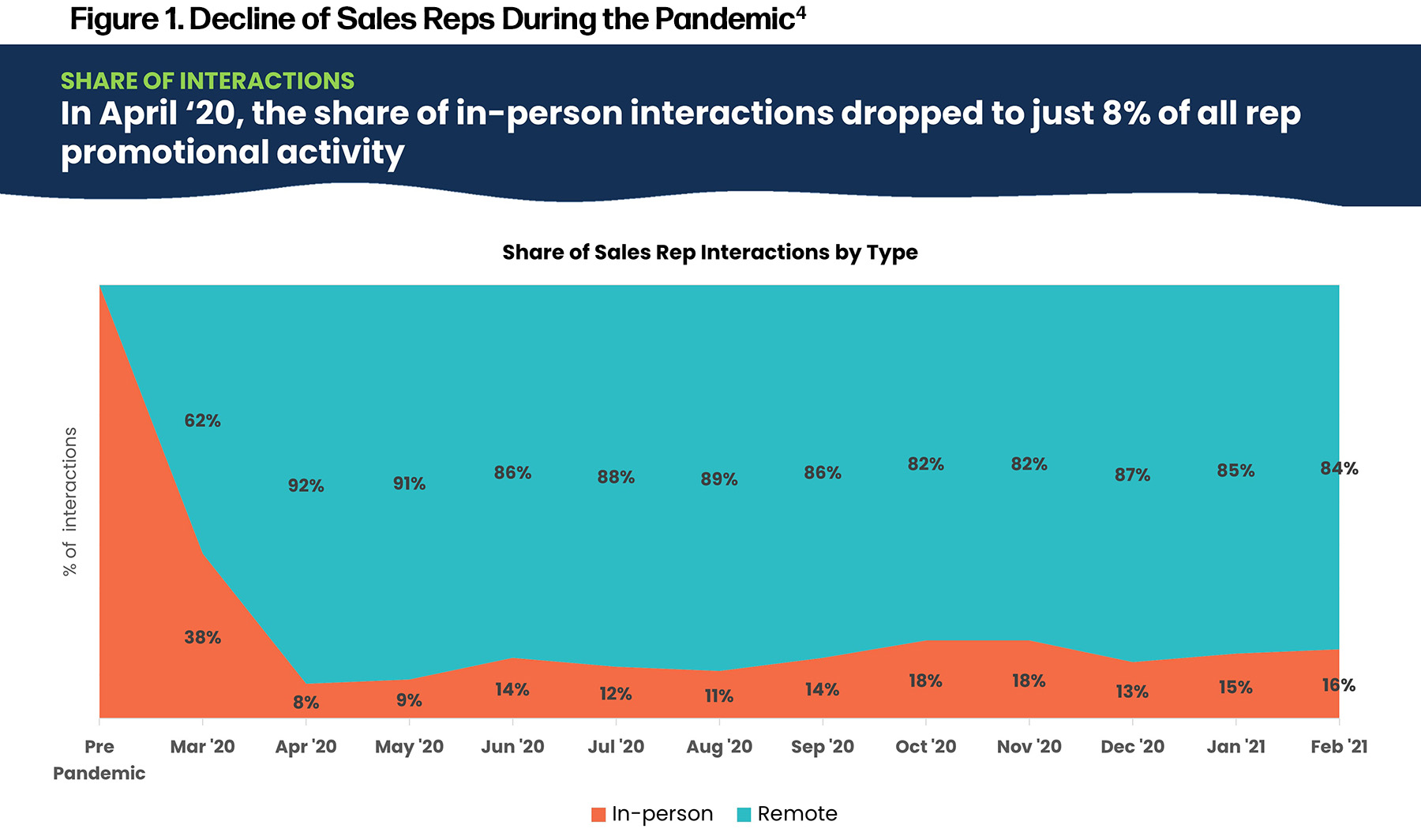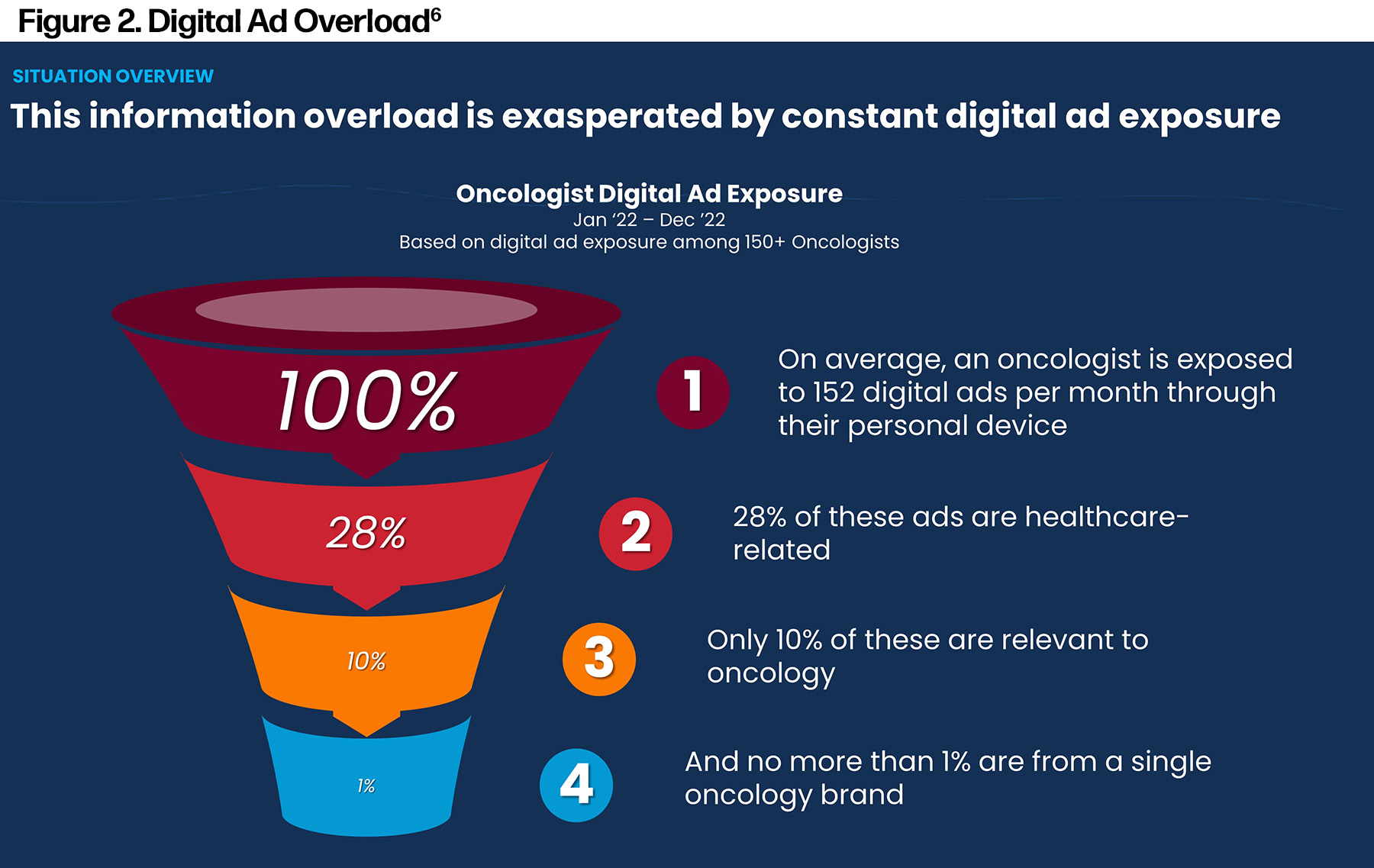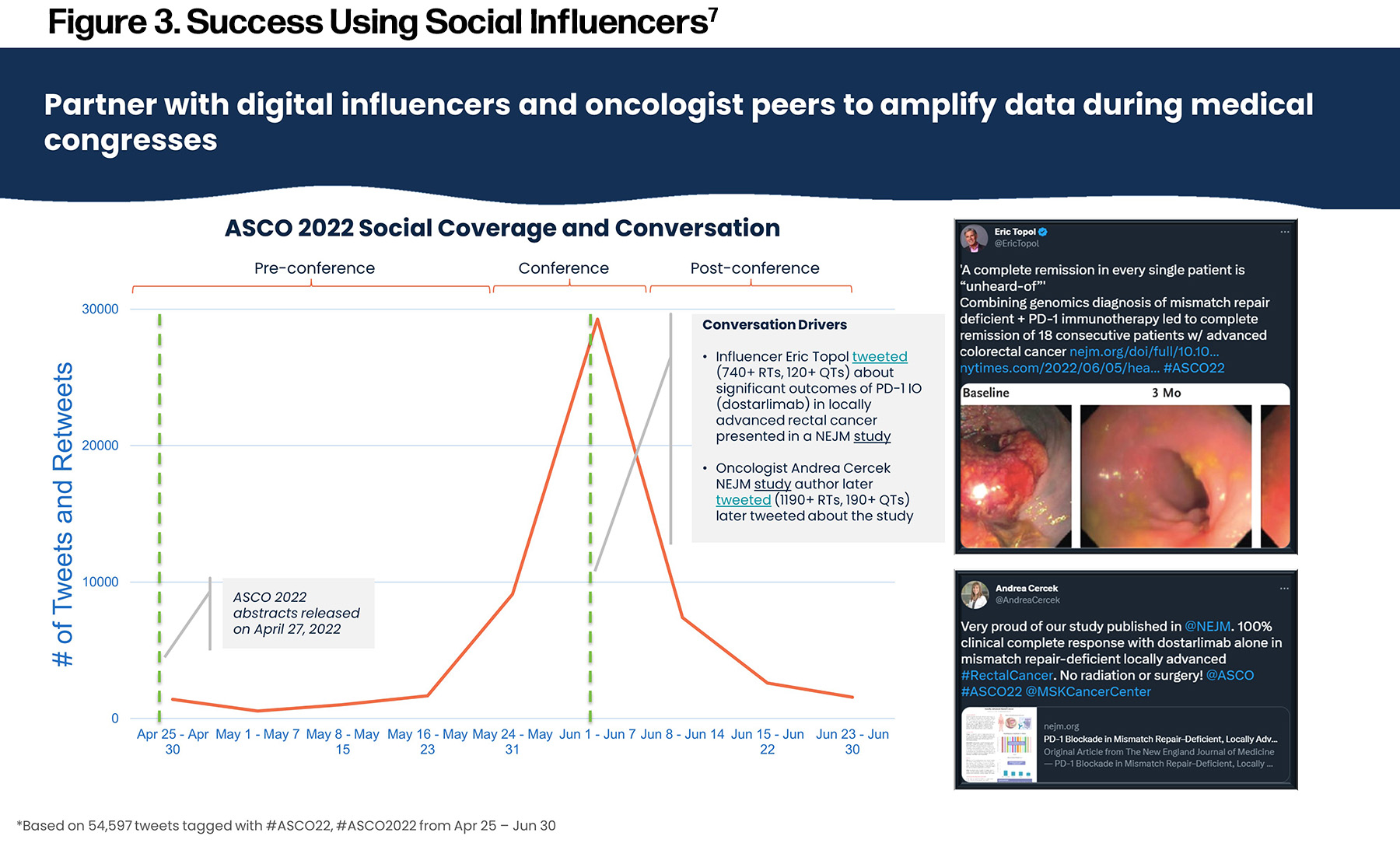The rep-centered pharmaceutical commercialization landscape is evolving. Overwhelmed healthcare professionals (HCPs) are gravitating towards alternative channels for information and guidance.1 This shift is driven by various factors, such as advances in technology, changes in HCPs’ preferences and attitudes, and the repercussions of the COVID-19 pandemic.
Of course, the industry has been anticipating the end of the sales rep era since the early 2000s, but in-person sales rep visits have remained persistent despite numerous changes throughout the years. Since 2000, there have been multiple instances where pharma giants such as Merck, Pfizer, AstraZeneca, and Novartis have downsized their field forces.2 These moves have not always been successful, as the reduction in the sales force was often followed by a decline in revenue.3
Where Are We Now?
While sales reps continue to be the single-largest marketing expenditure for most brands, efforts have shifted towards other channels. This shift is driven by increased scrutiny of the industry’s promotional practices, changing healthcare regulations, and the rise of digital technologies.
For example, brands such as GSK’s Shingrix focused on digital marketing and an immersive, engaging virtual reality (VR) experience for educational campaigns to promote the vaccine and educate HCPs. Lilly’s tirzepatide had a digital platform called “Lilly Connect” that allowed HCPs to connect with the company’s sales reps virtually rather than in person. The platform included features such as video calls, chat messaging, and educational resources.
So, why have in-person visits remained relevant despite these changes? Here are three reasons.
1. Inherent Complexity in Healthcare: The rapid and intricate evolution of healthcare products requires sales reps to educate HCPs on the features, benefits, and risks of products, as well as address their concerns.
“When’s the last time you bought something really complex from a telemarketer, right? Like, I know I don’t buy things, let alone am I going to make healthcare decisions for someone else based on some virtual interaction, but I think it’s still supplementing what the rep has done in a face-to-face call.” – VP, Sales and Commercial Strategy at a Urology Manufacturer
2. Human Relationships: The strong relationships forged between sales reps and HCPs over time contribute to the persistence of in-person meetings. Sales reps who have established trust and credibility with HCPs offer valuable advice and support, bridging the gap between HCPs and their patients, and ensuring that patients receive the best possible care.
“We’ve spent a lot of time, effort, and money building relationships with these different offices, and companies and what not, that I think there is a bit of a fear of just becoming another one of many digital marketing firms and you’re gonna lose that human touch.” – Senior Manager, Business Intelligence at a Neurology Manufacturer
3. Navigating the Maze: Sales reps can also help HCPs and offices manage information overload, navigate access challenges, and handle administrative tasks such as insurance coverage and reimbursement issues.
“I feel like there’s new stuff coming out every week, multiple times a week on some TKI or monoclonal for some indication, which has a name I’ve not heard before.” – Community Oncologist
Envisioning a World Without Sales Reps
While in-person sales rep visits remain a vital component of the industry, it’s evident pharma brands must adapt to the evolving landscape to succeed. To explore how pharma brands can thrive in this new world, we propose a useful thought experiment: how can brands adapt to a world entirely without in-person access to HCPs—for instance, during a second pandemic? How can brands continue to build strong relationships with HCPs and promote their products effectively?
The lessons we learned from the pandemic will be crucial in a world without in-person access. During COVID-19, virtual details replaced nearly all in-person interactions with companies swiftly training sales reps in the use of remote tools to maintain connections with HCPs (Figure 1). Although virtual details gained momentum, brand teams were acting asynchronously, leading to a highly uncoordinated multichannel effort.
 In a world without in-person access, brand teams must evolve existing channels, leverage data, and operate in unison to transition from a multichannel to an omnichannel approach, providing a personalized experience. Key channels that will evolve include:
In a world without in-person access, brand teams must evolve existing channels, leverage data, and operate in unison to transition from a multichannel to an omnichannel approach, providing a personalized experience. Key channels that will evolve include:
Channel #1 – Virtual Interactions
Pharma companies quickly responded to the challenges of a socially distanced world. However, each quarter since then, the proportion of virtual detailing has steadily decreased, ultimately resulting in a near 50/50 split of in-person versus virtual interactions.5
Delivering an effective virtual interaction is similar to an in-person interaction and involves:
- Being well-prepared in advance with the right tools and digital resources
- Active listening, empathy, and personalized communication
- Clear and concise messaging to address the specific needs of the HCP
- Knowledge and ability to answer questions to build trust and credibility
The main challenges for advancing virtual interactions will involve building trust and credibility through the virtual medium and comprehending the content that should be personalized based on HCP preferences. Virtual interactions will be a vital component that brand managers must skillfully execute over time.
Channel #2 – Digital Campaigns
Digital ads and social media campaigns have revolutionized the way pharma companies reach their target audience. With digital communication, anyone can be reached while also tracking campaigns to enhance and optimize their effectiveness.
Creating a memorable digital campaign involves addressing:
- What: Focus on a specific need with a call-to-action
- Where: The right platform matters, but format for the platform matters more
- How: Simple, clear, and visually appealing campaigns have stopping power
However, digital campaigns are increasingly crowded, with more ads competing for attention (Figure 2). As a result, very little is retained in the minds of HCPs. The key challenge for pharma marketers is to move beyond measuring campaigns by impressions and focus on their effectiveness. Connecting the success of a campaign with its real-world impact will be crucial in driving better results.
 Channel #3 – Conferences and Journals
Channel #3 – Conferences and Journals
Thirdly, integrating medical communications with other channels will be crucial in improving perceptions. Currently, medical communications through conferences, journals, and medical societies operate in silos, separate from the commercial organization, and are used primarily for disseminating information.
An effective medical communication strategy adds value by:
- Disseminating information at scale
- Partnering in educational programs, research, and advocacy efforts
- Coordinating well with other channels
The main challenge with medical communications lies in personalizing broad-based medical communications for individual HCPs. By leveraging other channels and breaking down silos, brand managers can launch a coordinated, multifaceted campaign that drives significant impact.
Channel #4 – Peer-to-peer Communication
Effective peer communication is never perceived as promotion, as one HCP stated: “It’s always best to hear about things like these [drug experiences] from colleagues I trust, rather than from a sales rep.”
Peer-to-peer communication or word of mouth is a high-trust channel, with credibility being a crucial factor. Currently, brands collaborate with key opinion leaders (KOLs) to develop or sponsor educational programs that provide valuable information to HCPs.
Partnering with digital influencers and KOLs around key announcements can drive social engagement and amplify the message. Dostarlimab (GSK’s Jemperli) successfully used this strategy, as they had their groundbreaking results shared by social influencers to generate engagement (Figure 3).7
 Channel #5 – Channels of the Future
Channel #5 – Channels of the Future
In a world without sales reps, the “channels of the future” will play a crucial role in disseminating information and educating HCPs about new treatments and therapies. These channels offer the potential for personalized, efficient, and accessible communication. Some of these future channels could include:
- Chatbots: With the recent success of generative AIs and large language models (LLMs), powerful chatbots are just weeks away that could answer HCPs’ questions on a variety of topics.
- On-demand Content: Netflix-style custom information, available anytime and anywhere. Focus on creating high-quality, engaging, and informative content that can be easily accessed and shared across various channels.
- Augmented Reality: With advancements, AR/VR is likely to explode. Tools should allow HCPs to interact with product information as detailed as they desire, from a high-level overview to a granular inspection.
Technology will disrupt in ways we might not yet imagine. Adaptability will be key for organizations to quickly embrace these innovative channels of the future.
Leveraging Data by Pharma Marketing Teams
As the world becomes increasingly diverse and digital, effective engagement presents a complex challenge. With numerous channels available and multiple teams within organizations vying to promote their products to HCPs and minimize access-related issues, central thought leadership is needed on how to mobilize resources to create a seamlessly integrated omnichannel experience. Pharma marketing teams must evolve by:
Crafting a Sound Data Strategy: This is of utmost importance, as it ensures clean and integrated customer data labeled with consistent terminology, enabling the unlocking of real-time enterprise-wide analytics. Handling information overload is equally important for pharma marketers.
Understanding Physicians: Physicians have a range of needs and preferences. They want answers to their specific questions, relayed in an engaging way, via their preferred medium. Consequently, creating an enhanced experience requires deep customer knowledge.
Delivering Personalized Experiences: Using the information we have on HCPs is crucial. By harnessing technologies such as AI/ML and LLMs, brands can perform dynamic analytics and modeling to deliver smart personalized campaigns.
Measuring and optimizing: Gone are the days of waiting for months to evaluate the successes and failures of a specific campaign; real-time feedback helps maximize the impact of marketing. Furthermore, brands can tailor their key performance indicators (KPIs) to specific campaign goals.
Putting Them Altogether
As the pharma industry undergoes a significant transformation in its commercialization approach, in-person sales rep visits continue to hold relevance but the industry must evolve and adapt to a shifting landscape. By advancing outreach channels, integrating communications, and capitalizing on data, pharma brands can thrive in a world without in-person access while delivering personalized experiences for HCPs. In the end, the future of pharma commercialization will necessitate a delicate equilibrium between technology and human relationships to educate and support HCPs in providing the best possible care for their patients.
References:
2. https://www.biopharmadive.com/news/AstraZeneca-job-cuts-700/432087.
4. https://zoomrx.com/reports/future-of-promotion/COVID19_Impact_ZoomRx_4_2021.pdf.
6. https://blog.zoomrx.com/win-in-a-crowded-digital-marketplace-white-paper.
7. https://twitter.com/EricTopol/status/1533506913165422597.











